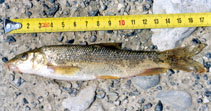| Family: |
Cyprinidae (Minnows or carps), subfamily: Barbinae |
| Max. size: |
19 cm SL (male/unsexed) |
| Environment: |
benthopelagic; freshwater |
| Distribution: |
Europe: endemic to the western Greece from Kalamas to Pamissos drainages. Introduced and established in the Isonzo River, northeastern Italy (Ref. 45688). |
| Diagnosis: |
Dorsal soft rays (total): 7-9. Diagnosed from other species of Barbus and Luciobarbus in Balkan Peninsula by having the following characters: last simple dorsal ray not stronger than branched rays, not serrated posteriorly; 47-53 + 2-3 scales on lateral line; 5-7 scale rows between lateral and pelvic base; small black spots (plain in some populations from Peloponnese) on head and body; often faint dark stripes or faint rows of dark spots along scale rows; lower lip with a median swollen pad (Ref. 59043). |
| Biology: |
Occurs in lakes and in water bodies on low-lying plains, with little current (Ref. 26100). Found in lower and upper parts of streams with stone bottom and current. Feeds on aquatic invertebrates (Ref. 59043). Threatened by water abstraction (Ref. 26100). Attains a maximum size of about 19 cm SL (Ref. 59043). |
| IUCN Red List Status: |
Least Concern (LC); Date assessed: 31 January 2006 Ref. (130435)
|
| Threat to humans: |
harmless |
Source and more info: www.fishbase.org. For personal, classroom, and other internal use only. Not for publication.

